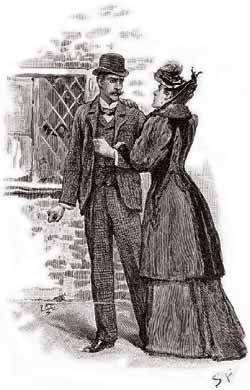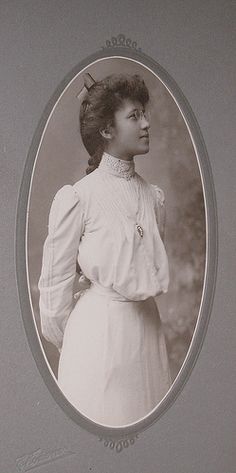Femme Friday: Effie Munro and Lucy Hebron
“The Yellow Face,” along with several other canonical Holmes stories, presents unavoidable difficulties for modern readers. In fact, at a recent convention, my fellow panelist suggested that this story should never even be printed. Before I get into the specifics of why Effie Munro and her daughter are some of the most inspiring women in the Holmes canon, I’d like to respectfully address why I disagree with this push for censorship.
First, it’s abundantly clear that the story is not politically correct by current standards. It contains problematic terminology and racial characterizations. However, these uncomfortable inclusions accurately reflect a time and place that, as much as they might disturb our sensibilities, did exist at one time. When Warner Brothers shows racially-charged vintage cartoons, they famously include a disclaimer to the effect that while they do not espouse the views of the cartoons, they believe it is harmful to ignore the prejudices that used to exist. As the ubiquitous quote tells us, if we choose to forget history, we’re doomed to repeat it. Stories like “The Yellow Face” remind us of how far we’ve come, but they also remind us of how far we still have to go when it comes to tolerance and respect for human differences.
Second, I am forever willing to defend “The Yellow Face,” because, in spite of being a man of his time in his use of terms and stereotypes, Doyle’s actual plotting of the story is a rallying cry for acceptance and love that were so far ahead of his time that it boggles the mind. It would be a truly ironic pity for a story that thumbs its nose at the ingrained injustice of the past to be lost to history because we can’t see the forest of positives for the problematic trees. That said, I’ll move onto the treasure trove of the story itself.
Original art by Marcia Dye: link to her blog and Etsy Shop
“The Yellow Face” begins in a grim way, with a likable man named Grant Munro seeking Holmes’s help to unravel the mystery of why his loving wife, Effie, has suddenly become secretive and given to lying and night-time rendezvous. Munro’s story itself reflects Doyle’s progressiveness. The man does not abuse, restrict, or otherwise belittle his obviously-troubled wife. He’s justifiably concerned by her behavior, but he does not resort to overbearing behavior to get the answer he seeks. He treats her as an equal, which she obviously is.
Effie’s behavior appears alarmingly erratic both to the reader and to Holmes, who immediately concocts an explanation for her actions that includes blackmail by her former, supposedly-deceased husband. Things don’t look very good for Grant, and they appear even worse for his wife.
 That’s when one of the most dramatic reversals in the entire canon occurs. A late-night confrontation by Holmes, Watson, and Munro finds none of the sordid details the detective supposed to be true. Instead, Effie is revealed to be the courageous mother of a secret child, desperate to be faithful to her little girl and to her husband. The reason for her secrecy is simple: Her first marriage was interracial, and her child is a reflection of that union. She, like the Victorian reader would have done, assumes that her husband shares the prejudices of his time and will not accept the fact that she is a widow of an interracial marriage or ever be able to love a child who looks so very different from the Victorian ideal.
That’s when one of the most dramatic reversals in the entire canon occurs. A late-night confrontation by Holmes, Watson, and Munro finds none of the sordid details the detective supposed to be true. Instead, Effie is revealed to be the courageous mother of a secret child, desperate to be faithful to her little girl and to her husband. The reason for her secrecy is simple: Her first marriage was interracial, and her child is a reflection of that union. She, like the Victorian reader would have done, assumes that her husband shares the prejudices of his time and will not accept the fact that she is a widow of an interracial marriage or ever be able to love a child who looks so very different from the Victorian ideal.
Effie, while admirably brave and indefatigably strong, is absolutely wrong. Grant Munro tenderly embraces his wife and her child, and the reader is left with the assurance that a new life, as a family, is ahead for the three of them. Now that we’ve looked at the story itself, I’ll move on to the themes that make Effie and her daughter such amazing women.
“The Yellow Face” is a remarkably feminist story, in addition to its progressive racial themes. It’s impossible to argue that Doyle wrote it to glorify Holmes’s skills, since the detective reads the situation entirely incorrectly and admits as much at the very end. It’s also not one that presents a wildly action-packed plot or complicated mystery. It’s extremely straightforward in both plot and message. Doyle very obviously wanted to make the statements he made, and he made them very clearly indeed. Let’s unpack some of these specifically feminist statements as embodied in the characters of Effie and Lucy.
First, when Grant Munro approaches Holmes, he presents a picture of his wife that reflects an intelligent, multi-dimensional woman who takes control of her own life and responsibilities. Of Effie, one of his first statements is, “She went out to America when she was young, and lived in the town of Atlanta, where she married.” There is no mention here of family connections or obligations. The reader is left to speculate about Effie’s reasons for going to America, but it’s clear that she’s a woman who is ready for adventure and who adapts to her surroundings. Continuing, Grant tells Holmes and Watson that after a yellow fever outbreak claimed the lives of her husband and (he believes) her child, she returned to England and settled on her own with the comfortable living her husband had left behind. Again, we are shown a woman who is not afraid to take the reins of her own life and who is far from desperate to land a man. Her subsequent marriage to Munro is presented as an entirely love-based union, devoid of any damsel-in-distress connotations. In fact, she enters the marriage as the financially-superior partner. As Effie’s portrait is first unveiled to us, we are shown, in no uncertain terms, that she is self-actualized, courageous, and mature.
Original art by Marcia Dye
Second, as the story unfolds, Effie’s actions prove her strength. Though her behavior seems underhanded at first, in the context of her situation, it becomes far more admirable. It’s not until the end of the story that we discover the truth of her interracial marriage, itself an almost unimaginably brave choice in the context of the American South of her time. Not only does she enter the union, but she also mothers a child of whom she is extremely proud. Her later secrecy has nothing to do with shame about her late husband or beloved child; it’s a protective gesture, designed to shelter herself and her daughter from her current husband’s rejection. She’s a fierce mother, willing to risk a huge amount to care for a child that many people of her time would have refused to acknowledge. Effie’s one miscalculation is in her assessment of Grant, who proves to be far more tolerant and admirable than she believed. Like him, the reader can forgive this one thing because her motives are so obviously honorable and extremely understandable.
 “The Yellow Face,” despite its issues, presents a woman who is smart, brave, decisive, and loyal, unwilling to reject her child in favor of a comfortable life free of others’ judgments. Even though she initially fails to realize the extent of Grant’s goodness, she is obviously also wise when it comes to her romantic choices, selecting two men to share her life who are honorable and kind beyond the limits of their time. As the child of such a mother, it’s hard to imagine Lucy growing up to be anything other than exceptional.
“The Yellow Face,” despite its issues, presents a woman who is smart, brave, decisive, and loyal, unwilling to reject her child in favor of a comfortable life free of others’ judgments. Even though she initially fails to realize the extent of Grant’s goodness, she is obviously also wise when it comes to her romantic choices, selecting two men to share her life who are honorable and kind beyond the limits of their time. As the child of such a mother, it’s hard to imagine Lucy growing up to be anything other than exceptional.
Some may see “The Yellow Face” as the relic of an age best forgotten, but I don’t believe Effie Munro or Lucy Hebron would approve. Sometimes, as readers, we open the pages of history and wade through context and bygone mores to find the diamonds hidden in plain sight among the things that we’d rather not remember.
Effie and her daughter are the creations of a man who operated within the confines of his time and society but also used his pen to joyfully and explosively break those confines wide open to present two women who deserve to be known and understood for years to come. May they never be forgotten in favor of stories we find easier to read.

Amy Thomas is a book reviewer, freelance essayist, and author of The Detective and The Woman mystery novel series featuring Sherlock Holmes and Irene Adler, published by MX Publishing. She holds a degree in professional communication and is an avid knitter, geek, and grammar nerd. Amy blogs about Sherlock Holmes at Girlmeetssherlock.wordpress.com and can be reached for professional enquiries at nottinghillnapoleon@gmail.com. Connect with her on Twitter @Pickwick12.




Thanks so much for such a thoughtful analysis of The Yellow Face. You make many good points for refusing to neglect a good story for some surface problems that are due to age rather than philosophy. I think this may be good fodder for Mr. Gatiss and “the Moff” for a John and Mary Watson story. We have at least a year to wait….
Keep up the good work!
Please note my comments on this storyare published and availableto anyone who requests it on line:
Scientific Lesson Learned from “The Yellow Face” by Carl l. Heifetz
Published in Holmes & Watson Report, 8 (1): 33-36, (March) 2004
I would definitely like to read your treatise, Carl! My email is SHagins_17551@yahoo.com PLease send a reply there, as I am not updated about replies here
My treatise is available to anyone who requests it.
I admire all the characters in this story. They represent the tolerance that the new world was supposed to embrace.
Gretchen Foster